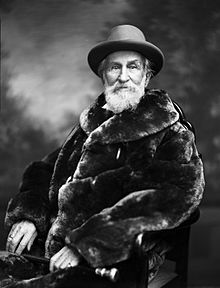
Summary
Nathaniel Kimball "N.K." Boswell (1836–1921) was an American frontiersman, rancher, cowboy and lawman of the Old West, best known for building the N.K. Boswell Ranch, considered a historical location of Wyoming today. He also helped to settle Laramie, Wyoming.
Nathaniel Kimball Boswell | |
|---|---|
 | |
| Born | November 4, 1836 |
| Died | October 12, 1921 (aged 84) Laramie, Wyoming, US |
| Known for | Wild West Lawman |
Impact on Laramie, Wyoming, Steve Long lynching edit
Boswell ventured into Wyoming Territory around 1865 towards the end of the American Civil War. He is believed to have served in the Union Army, but it is not certain as to from which state he originated, although it is believed he may have come from New Jersey. Boswell arrived in the area of present-day Laramie, Wyoming, as one of its first settlers. He was joined there by his brother George Boswell and his family. At the time, that area was extremely rough and wild, with numerous outlaws drawn to it due to the lack of law enforcement. Three of those would be early western gunman "Big" Steve Long, and his half brothers Ace and Con Moyer. Long would become the Marshal of Laramie, whereas Boswell would be the first Sheriff of Albany County, Wyoming, where Laramie is located. Almost immediately the two lawmen were at odds.[1][2]
Boswell was an original member of the local "Vigilance Committee", organized to help bring order to the lawless area. Long and his brothers, however, opened a saloon called the Bucket of Blood, and began strongarming settlers into signing away their property. If they refused, they were more times than not killed. At times, Long would goad them into a fight and shoot them down, at others they were merely killed under mysterious circumstances. In May 1868, Melville C. Brown was elected mayor, but he soon resigned due to the incompetence of city's other officials.[3] By October 1868, Long had killed thirteen men in gunfights, and several others were suspected to have been killed by him, but only those thirteen are confirmed to have died by his hand.[2]
Boswell organized the citizens, and suggested they wait, and eventually Long would put himself in a position to where they could act against him. On October 18, 1868 Long attempted to rob a prospector named Rollie "Hard Luck" Harrison. Harrison produced a pistol, and a gunfight erupted between the two. Long was wounded and retreated. Harrison was killed, dying as a result of his wounds before he was able to relay who shot him to anyone else.
Long confessed to his fiancé how he was wounded, and she in turn told Sheriff Boswell[4]189. Boswell organized several men in the town, and they entered the saloon owned by Long and his brothers on October 28. The mob overwhelmed the three and led them to an unfinished cabin in town. Long was quiet throughout the process, having only one request, that he be allowed to remove his boots, stating "My mother always said I'd die with my boots on". Barefoot, he was lynched along with Con and Ace Moyer by hanging them from the rafters of the cabin. There were no legal actions taken against the members of the lynch mob.[5]
Later life edit
By this time, Boswell's ranch had become one of the largest and most productive in the territory. One of his fellow lynching vigilantes, L. P. Griswold, moved to Denver, Colorado. He formed a "Vigilance Committee" there in 1872, but was arrested for doing so. Believing he stood no chance if brought to trial, Griswold escaped, and was shot and killed while doing so. Boswell, however, continued to be a prominent figure in Wyoming. In 1872, Boswell served as the first warden of the Wyoming Territorial Prison. He died of unknown causes in 1921. His ranch in Wyoming is now listed on the National Register of Historic Places.[6][7]
References edit
- ^ "Charismatic lawman N.K. Boswell; He brought law and order to Laramie". Albany County Historical Society. Retrieved 2024-01-13.
- ^ a b "Laramie Mayor, Former Sheriff Both Die With Boots Off Despite Vigilante History". Albany County Historical Society. Retrieved 2024-01-13.
- ^ Frontier Index. 16 June 1868.
- ^ O'Neal, Bill (1979). Encyclopedia of Western Gunfighters. University of Oklahoma Press. ISBN 978-0-8061-2335-6.
- ^ "Museums & History Legends of Laramie Bucket of Blood Saloon | Visit Laramie". www.visitlaramie.org. Retrieved 2024-01-13.
- ^ "National Register Information System". National Register of Historic Places. National Park Service. July 9, 2010.
- ^ Junge, Mark (October 22, 1976). "National Register of Historic Places Inventory - Nomination Form: N.K. Boswell Ranch". National Park Service. Retrieved 28 August 2013.
External links edit
- Cattlemans Commonwealth of the Western Range
- Hal Mansfield Writings, N. K. Boswell
- Sheriff Boswell Reports on Prison Conditions
- N. K. Boswell at Find a Grave


